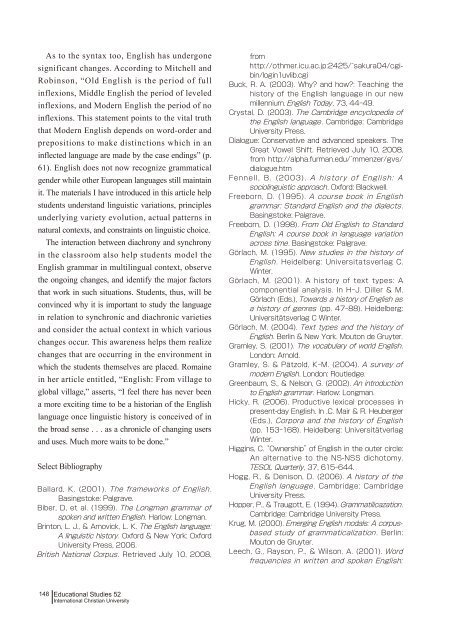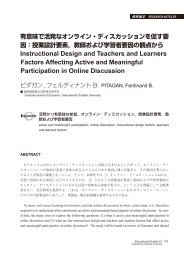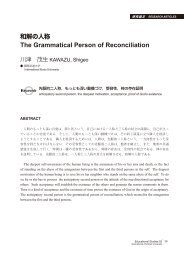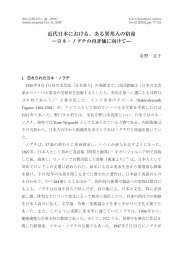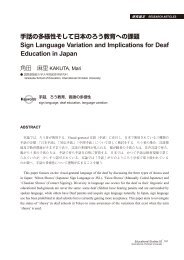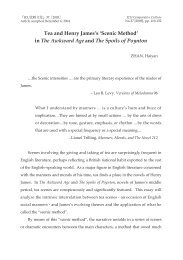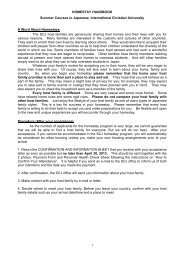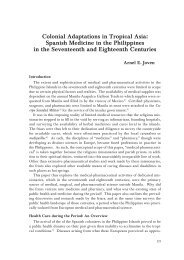Incorporating Multilingualism in the Development of the English ...
Incorporating Multilingualism in the Development of the English ...
Incorporating Multilingualism in the Development of the English ...
You also want an ePaper? Increase the reach of your titles
YUMPU automatically turns print PDFs into web optimized ePapers that Google loves.
As to <strong>the</strong> syntax too, <strong>English</strong> has undergonesignificant changes. Accord<strong>in</strong>g to Mitchell andRob<strong>in</strong>son, “Old <strong>English</strong> is <strong>the</strong> period <strong>of</strong> full<strong>in</strong>flexions, Middle <strong>English</strong> <strong>the</strong> period <strong>of</strong> leveled<strong>in</strong>flexions, and Modern <strong>English</strong> <strong>the</strong> period <strong>of</strong> no<strong>in</strong>flexions. This statement po<strong>in</strong>ts to <strong>the</strong> vital truththat Modern <strong>English</strong> depends on word-order andprepositions to make dist<strong>in</strong>ctions which <strong>in</strong> an<strong>in</strong>flected language are made by <strong>the</strong> case end<strong>in</strong>gs” (p.61). <strong>English</strong> does not now recognize grammaticalgender while o<strong>the</strong>r European languages still ma<strong>in</strong>ta<strong>in</strong>it. The materials I have <strong>in</strong>troduced <strong>in</strong> this article helpstudents understand l<strong>in</strong>guistic variations, pr<strong>in</strong>ciplesunderly<strong>in</strong>g variety evolution, actual patterns <strong>in</strong>natural contexts, and constra<strong>in</strong>ts on l<strong>in</strong>guistic choice.The <strong>in</strong>teraction between diachrony and synchrony<strong>in</strong> <strong>the</strong> classroom also help students model <strong>the</strong><strong>English</strong> grammar <strong>in</strong> multil<strong>in</strong>gual context, observe<strong>the</strong> ongo<strong>in</strong>g changes, and identify <strong>the</strong> major factorsthat work <strong>in</strong> such situations. Students, thus, will beconv<strong>in</strong>ced why it is important to study <strong>the</strong> language<strong>in</strong> relation to synchronic and diachronic varietiesand consider <strong>the</strong> actual context <strong>in</strong> which variouschanges occur. This awareness helps <strong>the</strong>m realizechanges that are occurr<strong>in</strong>g <strong>in</strong> <strong>the</strong> environment <strong>in</strong>which <strong>the</strong> students <strong>the</strong>mselves are placed. Roma<strong>in</strong>e<strong>in</strong> her article entitled, “<strong>English</strong>: From village toglobal village,” asserts, “I feel <strong>the</strong>re has never beena more excit<strong>in</strong>g time to be a historian <strong>of</strong> <strong>the</strong> <strong>English</strong>language once l<strong>in</strong>guistic history is conceived <strong>of</strong> <strong>in</strong><strong>the</strong> broad sense . . . as a chronicle <strong>of</strong> chang<strong>in</strong>g usersand uses. Much more waits to be done.”Select BibliographyBallard, K. (2001). The frameworks <strong>of</strong> <strong>English</strong>.Bas<strong>in</strong>gstoke: Palgrave.Biber, D, et al. (1999). The Longman grammar <strong>of</strong>spoken and written <strong>English</strong>. Harlow: Longman.Br<strong>in</strong>ton, L. J., & Arnovick, L. K. The <strong>English</strong> language:A l<strong>in</strong>guistic history. Oxford & New York: OxfordUniversity Press, 2006.British National Corpus. Retrieved July 10, 2008,fromhttp://othmer.icu.ac.jp:2425/~sakura04/cgib<strong>in</strong>/log<strong>in</strong>1uvlib.cgiBuck, R. A. (2003). Why? and how?: Teach<strong>in</strong>g <strong>the</strong>history <strong>of</strong> <strong>the</strong> <strong>English</strong> language <strong>in</strong> our newmillennium. <strong>English</strong> Today, 73, 44–49.Crystal, D. (2003). The Cambridge encyclopedia <strong>of</strong><strong>the</strong> <strong>English</strong> language. Cambridge: CambridgeUniversity Press.Dialogue: Conservative and advanced speakers. TheGreat Vowel Shift. Retrieved July 10, 2008,from http://alpha.furman.edu/~mmenzer/gvs/dialogue.htmFennell, B. (2003). A history <strong>of</strong> <strong>English</strong>: Asociol<strong>in</strong>guistic approach. Oxford: Blackwell.Freeborn, D. (1995). A course book <strong>in</strong> <strong>English</strong>grammar: Standard <strong>English</strong> and <strong>the</strong> dialects.Bas<strong>in</strong>gstoke: Palgrave.Freeborn, D. (1998). From Old <strong>English</strong> to Standard<strong>English</strong>: A course book <strong>in</strong> language variationacross time. Bas<strong>in</strong>gstoke: Palgrave.Görlach, M. (1995). New studies <strong>in</strong> <strong>the</strong> history <strong>of</strong><strong>English</strong>. Heidelberg: Universitatsverlag C.W<strong>in</strong>ter.Görlach, M. (2001). A history <strong>of</strong> text types: Acomponential analysis. In H–J. Diller & M.Görlach (Eds.), Towards a history <strong>of</strong> <strong>English</strong> asa history <strong>of</strong> genres (pp. 47–88). Heidelberg:Universitätsverlag C W<strong>in</strong>ter.Görlach, M. (2004). Text types and <strong>the</strong> history <strong>of</strong><strong>English</strong>. Berl<strong>in</strong> & New York. Mouton de Gruyter.Gramley, S. (2001). The vocabulary <strong>of</strong> world <strong>English</strong>.London: Arnold.Gramley, S. & Pätzold, K–M. (2004). A survey <strong>of</strong>modern <strong>English</strong>. London: Routledge.Greenbaum, S., & Nelson, G. (2002). An <strong>in</strong>troductionto <strong>English</strong> grammar. Harlow: Longman.Hicky, R. (2006). Productive lexical processes <strong>in</strong>present-day <strong>English</strong>. In .C. Mair & R. Heuberger(Eds.), Corpora and <strong>the</strong> history <strong>of</strong> <strong>English</strong>(pp. 153–168). Heidelberg: UniversitätverlagW<strong>in</strong>ter.Higg<strong>in</strong>s, C. “Ownership”<strong>of</strong> <strong>English</strong> <strong>in</strong> <strong>the</strong> outer circle:An alternative to <strong>the</strong> NS-NSS dichotomy.TESOL Quarterly, 37, 615–644.Hogg, R., & Denison, D. (2006). A history <strong>of</strong> <strong>the</strong><strong>English</strong> language. Cambridge: CambridgeUniversity Press.Hopper, P., & Traugott, E. (1994). Grammatilicazation.Cambridge: Cambridge University Press.Krug, M. (2000). Emerg<strong>in</strong>g <strong>English</strong> modals: A corpusbasedstudy <strong>of</strong> grammaticalization. Berl<strong>in</strong>:Mouton de Gruyter.Leech, G., Rayson, P., & Wilson, A. (2001). Wordfrequencies <strong>in</strong> written and spoken <strong>English</strong>:148Educational Studies 52International Christian University


